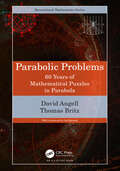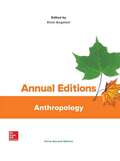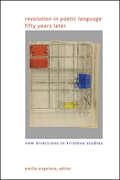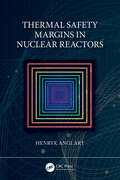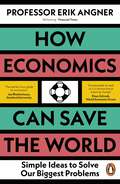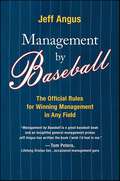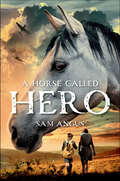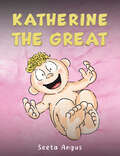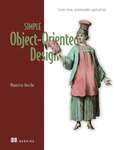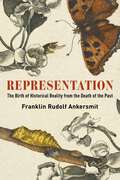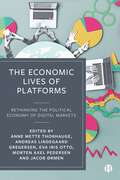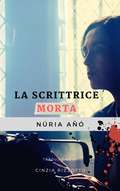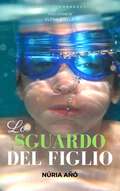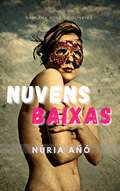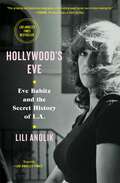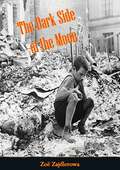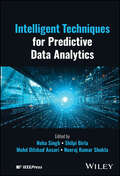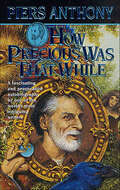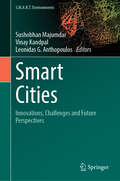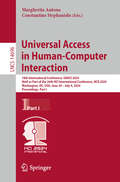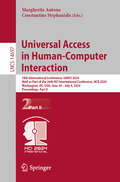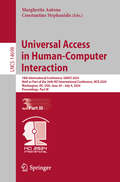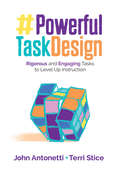- Table View
- List View
Parabolic Problems: 60 Years of Mathematical Puzzles in Parabola (AK Peters/CRC Recreational Mathematics Series)
by David Angell Thomas BritzParabola is a mathematics magazine published by UNSW, Sydney. Among other things, each issue of Parabola has contained a collection of puzzles/problems, on various mathematical topics and at a suitable level for younger (but mathematically sophisticated) readers.Parabolic Problems: 60 Years of Mathematical Puzzles in Parabola collects the very best of almost 1800 problems and puzzles into a single volume. Many of the problems have been re-mastered, and new illustrations have been added. Topics covered range across geometry, number theory, combinatorics, logic, and algebra. Solutions are provided to all problems, and a chapter has been included detailing some frequently useful problem-solving techniques, making this a fabulous resource for education and, most importantly, fun!Features Hundreds of diverting and mathematically interesting problems and puzzles. Accessible for anyone with a high school-level mathematics education. Wonderful resource for teachers and students of mathematics from high school to undergraduate level, and beyond.
Classroom Assessment Techniques: Formative Feedback Tools for College and University Teachers
by Thomas A. Angelo Todd D. ZakrajsekClassroom Assessment Techniques: Formative Feedback Tools for College and University Teachers A practical, research-based handbook for using assessment to improve learning. This completely revised and updated third edition of Classroom Assessment Techniques provides a research-based, engaging guide to assessing student learning where it matters most—at course and classroom levels. Informed by the latest international educational research and 30 years of classroom assessment practice, this practical handbook is designed for postsecondary teachers from all disciplines, faculty and academic developers, and assessment professionals. It offers field-tested guidance, tools, and advice for planning, designing, and implementing formative assessment in face-to-face, hybrid, and fully online classrooms, analyzing resulting data, and using that data to improve student learning. Classroom Assessment Techniques, 3rd Edition, is a practical, clearly written handbook for busy professionals. It contains a wealth of useful resources, including: 50-plus CATs (classroom assessment techniques) – flexible formative assessment tools easily adaptable for use in a wide range of disciplines and contexts. Case studies and examples illustrating how college and university faculty have applied these techniques to improve learning A new “Course Learning Outcomes Inventory” (CLOI)—a self-assessment tool for identifying and prioritizing the most relevant learning outcomes to assess The original “Teaching Goals Inventory” (TGI) which offers an alternate, teaching-focused approach to setting assessment priorities Multiple ways to quickly find the most appropriate tool. CATs are indexed by discipline examples, Bloom’s Taxonomy, Biggs and Tang’s SOLO Taxonomy, the CLOI, and the TGI Brief chapters explaining what formative assessment is, how it can improve student learning, how to gather and provide formative feedback, how to link classroom assessment with broader/other assessment efforts, and how to collaborate with students and colleaguesEach CAT provides a brief, self-contained “recipe” including a description, steps for implementation, dos and don’ts, and relevant references
Annual Editions: Anthropology
by Elvio AngeloniThe Annual Editions series is designed to provide convenient inexpensive access to a wide range of current articles from some of the most respected magazines, newspapers and journals published today. Annual Editions are updated on a regular basis through a continuous monitoring of over 300 periodical sources. The articles selected are authored by prominent scholars, researchers, and commentators writing for a general audience. Each Annual Editions volume has a number of features designed to make them especially valuable for classroom use; including a brief overview for each unit, as well as Learning Outcomes, Critical Thinking questions, and Internet References to accompany each article. Go to the McGraw-Hill Create Annual Editions Article Collection at http://www.mcgrawhillcreate.com/annualeditions to browse the entire collection. Select individual Annual Editions articles to enhance your course, or access and select the entire Angeloni: Annual Editions: Anthropology, 42/e book here http://create.mheducation.com/createonline/index.html#qlink=search%2Ftext%3Disbn:126018031X for an easy, pre-built teaching resource. Visit http://create.mheducation.com for more information on other McGraw-Hill titles and special collections.
"Revolution in Poetic Language" Fifty Years Later: New Directions in Kristeva Studies (SUNY series in Gender Theory)
by Emilia AngelovaIn her 1974 Revolution in Poetic Language, Julia Kristeva resisted the abstract use of language, with its aim of totalization and finality, in all its colonizing and alienating forms. A major thinker and critic, Kristeva reappropriated Hegel's concepts of desire and negativity, in conjunction with the thought of Heidegger, Arendt, Freud, and Lacan, to revolt against modernity's culture of nihilism and the West's inability to deal with loss. This collection celebrates the fiftieth anniversary of Revolution in Poetic Language by revisiting Kristeva's oeuvre and establishing exciting new directions in Kristeva studies. Engaging with queer and transgender studies, disability studies, decolonial studies, and more, renowned and rising scholars plot continuities in—and push the boundaries of—Kristeva's thinking about loss, revolution, and revolt. The volume also includes two essays by Kristeva, translated into English for the first time here—"The Impossibility of Loss" (1988) and "Of What Use Are Poets in Times of Distress?" (2016).
Thermal Safety Margins in Nuclear Reactors
by Henryk AnglartThis book presents an overview of state-of-the art approaches to determine thermal safety margins in nuclear reactors. It presents both the deterministic and probabilistic aspects of thermal safety margins of nuclear reactors to facilitate the understanding of these two difficult topics at various academic levels, from undergraduates to researchers in nuclear engineering.It first sets out the theoretical background before exploring how to determine thermal safety margins in nuclear reactors, through examples, problems and advanced state-of-the-art approaches. This will help undergraduate students better understand the most fundamental aspects of nuclear reactor safety. For researchers and practitioners, this book provides a comprehensive overview of most recent achievements in the field, offering an excellent starting point to develop new methods for the assessment of the thermal safety margins.This book is written to bridge the gap between deterministic and appropriate treatment of uncertainties to assess safety margins in nuclear reactors, presenting these approaches as complementary to each other. Even though these two approaches are frequently used in parallel in real-world applications, there has been a lack of a consistent teaching approach in this area.This book is suitable for readers with a background in calculus, thermodynamics, fluid mechanics, and heat transfer. It is assumed that readers have previous exposure to such concepts as laws of thermodynamics, enthalpy, entropy, and conservation equations used in fluid mechanics and heat transfer.Key Features: Covers the theory, principles, and assessment methods of thermal safety margins in nuclear reactors whilst presenting the state-of-the-art technology in the field Combines the deterministic thermal safety considerations with a comprehensive treatment of uncertainties, offering a framework that is applicable to all current and future commercial nuclear reactor types Provides numerous examples and problems to be solved
How Economics Can Save the World: Simple Ideas to Solve Our Biggest Problems
by Erik AngnerEconomics has the power to make the world a better, happier and safer place: this book shows you howOur world is in a mess. The challenges of climate change, inequality, hunger and a global pandemic mean our way of life seems more imperilled and society more divided than ever; but economics can help!From parenting to organ donation, housing to anti-social behaviour, economics provides the tools we need to fix the biggest issues of today. Far from being a means to predict the stock market or enrich the elite, economics provides a lens through which we can better understand how things work, design clever solutions and create the conditions in which we can all flourish.With a healthy dose of optimism, and packed with stories of economics in everyday situations, Erik Angner demonstrates the methods he and his fellow economists use to help improve our lives and the society in which we live. He shows us that economics can be a powerful force for good, awakening the possibility of a happier, more just and more sustainable world.
Management by Baseball: The Official Rules for Winning Management in Any Field
by Jeff AngusWhat do Hall of Fame baseball managers like Connie Mack and John McGraw have in common with today's business leaders? Why are baseball managers like Joe Torre and Dusty Baker better role models for business, government, and non–profit management than respected corporate giants like Jack Welch and Bill Gates? And just what does Peter Drucker have to do with Oriole ex–manager Earl Weaver? Management consultant, baseball writer, and columnist for InformationWeek, Computerworld, and InfoWorld, Jeff Angus shows how anyone can become a better manager by taking lessons from the leaders and nuances of the one game that is the truest test of managerial prowess. As proven by Angus' highly popular blog, Management by Baseball is a fun, story–filled guide that gives managers and anyone in business practical, actionable, understandable tools they can use to improve performance: How do you start an organization from scratch? Take a page from baseball's 19th century origins. How do you adapt to changing markets and social conditions? Learn from the man who invented Babe Ruth. What are the simplest ways to turn around a weak department? Pick up Dick Williams' proven tactics. How do you redesign corporate strategy in response to your competitors? Learn Joe Torre's secret advantage. How do you develop emotional intelligence as a leader? Find out how Ichiro Suzuki made his transition from Japan to the Major Leagues a historic success
A Horse Called Hero
by Sam AngusIn A Horse Called Hero by Sam Angus, it is the brink of World War II, and a family forced out of their London home flees to the country. Wolfie and his older sister Dodo are devastated to leave behind everything they've ever known, but they begin settling into their new life.One day, they come across an orphaned fowl, which they raise as Hero, a strong and beautiful horse who lives up to his name when he saves the children from a fire.Wolfie and Dodo find comfort in their new life, but the war is escalating quickly and horses are needed for combat. One night, Hero is stolen, and the children are shattered. Years then pass without any indication Hero will return. It's only when Wolfie becomes a stable hand that he discovers Hero has ended up working in the mines under terrible conditions. Then and there, Wolfie resolves to save Hero, a plan that places both of their lives in jeopardy. Together again, can they will survive?
Katherine the Great
by Seeta AngusFrom the moment she arrives, Alfred’s baby sister Katherine is destined for greatness! She knows it deep down, and she’s determined to make sure the whole family knows it too! But Alfred has a clever trick up his sleeve! Could it have something to do with Great Granny’s secret recipe for irresistible chocolate mice treats?
Simple Object-Oriented Design: Create clean, maintainable applications
by Mauricio AnicheWrite object-oriented code that&’s manageable, maintainable, and future-proof.Keeping your object-oriented designs simple demands a creative approach—and that&’s exactly what you&’ll find in Simple Object-Oriented Design. This book is full of patterns and principles for reducing complexity, each one proven in author Mauricio Aniche&’s 20-year career in software development. You&’ll learn how to tackle code&’s natural growth in complexity, and adopt a &“good enough&” approach that means it&’s easy to refactor when requirements change. You&’ll discover insightful principles for: Making code readable and documented Improving consistency and encapsulation Managing dependencies Designing abstractions Handling infrastructure Effective modularization Learn what constitutes both good and bad object-oriented software design, discover how to make better trade-offs in design decisions, and when to embrace complexity over simpler data structures. With this book as your vital reference, you&’ll be ready to write code that will last the test of time, without slowing feature delivery to a crawl. About the technology Even a simple object-oriented application can quickly become complex as it evolves. Each new class, method, or feature means more state and abstractions to manage, which in turn increases complexity, maintenance, and time spent detangling legacy code. It takes effort and skill to keep your codebase simple. This book shows you how. About the book Simple Object-Oriented Design: Create clean, maintainable applications presents practical design principles you can use to keep an object-oriented codebase simple as it grows and changes. Written as a collection of practical techniques you can apply in any OO language, it offers tips for concise code, managing dependencies and modules, and designing flexible abstractions. Illuminating figures, real-world examples, and insightful exercises make each principle stick. What's inside Writing simple, understandable classes Flexible abstractions to extend your designs Reducing the impact of coupling About the reader Readers should be familiar with an object-oriented language like Java, C#, or Python. About the author Maurício Aniche is a software engineer with 20 years of experience. He&’s also an Assistant Professor in Software Engineering at Delft University of Technology, and the author of Effective Software Testing. Table of Contents 1 It&’s all about managing complexity 2 Making code small 3 Keeping objects consistent 4 Managing dependencies 5 Designing good abstractions 6 Handling external dependencies and infrastructure 7 Achieving modularization 8 Being pragmatic
Representation: The Birth of Historical Reality from the Death of the Past (Columbia Themes in Philosophy)
by Franklin Rudolf AnkersmitWhat makes historical writing distinctive? In Representation, Franklin Rudolf Ankersmit—the preeminent figure in the philosophy of history today—offers a deeply original way of understanding the practice of historical writing and a powerful vindication of history as an empirical discipline. Based on a new reading of the philosophy of G. W. Leibniz, Ankersmit constructs a rigorous framework for understanding the nature of historical argument.Representation argues that while previous states of affairs have left evidence that can be used to formulate true statements, the past itself is irretrievably lost. A condition of historical writing is that the past as such does not exist. Historical texts are best understood as complex signs that mutually criticize one another to compose a historical reality fundamentally distinct from common-sense notions of the past.Representation casts an entirely new light on fundamental concepts such as historical truth, historical debate, and historical rationality. Cogent, forceful, and provocative, this book is the most ambitious work in the philosophy of history in many years.
Vichara Sanchaya - 3: ವಿಚಾರ ಸಂಚಯ - 3
by Dr Annamma T. S Kantarajyyaವಿಚಾರ ಸಂಚಯ - 3 CBCS ಹೊಸ ಪಠ್ಯಕ್ರಮ B.A./ B.S.W./ B.F.A./ B.V.A. ಮೂರನೇ ಸೆಮಿಸ್ಟರ್ ಕನ್ನಡ ಭಾಷಾ ಪಠ್ಯಕ್ರಮ 2017-18 ಅನ್ನು ಶೈಕ್ಷಣಿಕ ವರ್ಷದಿಂದ ಅನುಷ್ಠಾನಕ್ಕೆ ಸಿದ್ಧಪಡಿಸಲಾಗಿದೆ.
The Economic Lives of Platforms: Rethinking the Political Economy of Digital Markets
by Anne Mette Thorhauge, Andreas Lindegaard Gregersen, Eva Iris Otto, Jacob Ørmen and Morten Axel PedersenThis interdisciplinary collection rethinks the political economy of the digital market by asking what came before platforms and suggesting what might come after them. By unpacking the concept of ‘platform economies’ into locally embedded variations of digital markets, the book identifies what is new about contemporary platforms and what is characteristic of wider historical, social and economic currents. The diverse team of authors employ various analytical approaches, including in-depth ethnographic studies, and theoretical and analytical reconceptualizations of platforms and the industries they encompass.Tapping into current themes including the decolonisation of the internet, this book offers a timely assessment of the implications of emerging reconfigurations between technology, information, society and markets.
La scrittrice morta
by Núria AñóAnna è una scrittrice di mezz’età che ha cresciuto sua figlia da sola. Ora Berta è cresciuta e i dubbi che comporterebbe conoscere suo padre, che ha visto solo in foto, sembrano sollevarsi proprio quando il rapporto col suo fidanzato entra in crisi. Hans lavora in fabbrica e ha una sorella, Clara, una ragazza incompresa che vive con l’ossessione per un ragazzo che guida una moto gialla. Ma questa è, innanzitutto, la storia di Anna Flieder; quando decide di scrivere un’opera dallo stile più biografico, l’ispirazione le fa visita assumendo la forma dell’uomo che ha abbandonato molti anni prima. "La storia riflette il processo creativo dell’autrice. [...] È un’opera rivolta a coloro che amano leggere e che si lasciano assorbire dalla lettura, lasciando grande spazio all’immaginazione e molto all’intuizione" –Recensione del quotidiano La Mañana Il romanzo catalano L'escriptora morta di Núria Añó è stato pubblicato in formato cartaceo da Editorial Omicron nel 2008.
Lo sguardo del figlio
by Núria AñóPaula è una maestra della scuola materna che non può avere figli. Così, con il marito, adotta Daniel, un bambino con i capelli rossi. Dopo un po’ di anni, la madre biologica del bambino compare all’improvviso in quello scenario idilliaco, distruggendo la pace che aveva regnato fino a quel momento. Passando per diverse fasi, dall’arrivo del bambino in quella casa a quando diventa un adulto, Lo sguardo del figlio ci presenta diversi personaggi, come la nonna, una donna forte che nutre un grandissimo amore per il nipote e che, però, insieme a Paula, rappresenta la relazione problematica tra madri e figli; o Sophie, la ragazza che compare nel suo ingresso all’adolescenza. Con un sottofondo di danza classica, assisteremo a una storia d’amore che lascerà un’impronta e con cui ognuno di noi ha più cose in comune di quello che pensa. "Si tratta di una lettura molto interessante e che non ci lascia indifferenti: è un invito a riflettere in un mondo nel quale la banalità impera."– Dra. Àngels Santa, rivista letteraria L'Ull crític, 17-18 "Il lettore trova una narrazione stimolante, che lo introduce nei sentimenti di diversi personaggi e che richiede una certa sensibilità per comprendere ogni vita che si muove nella storia."– Dra. Alexandra Santos Pinheiro, Resonancias Literarias no. 153 "Una letteratura intimista, quasi sussurrata, che parla più dei personaggi e dei loro stati d’animo che delle cose."– Justo Sotelo, professore "Ricerca dell’identità, sensi di colpa sotterrati -non così tanto a volte-, l’angoscia perenne di fronte alla possibilità della perdita e l’amore che supera i legami di sangue sono alcuni dei temi che il lettore troverà in questo romanzo. [...] Fatti apparentemente irrilevanti e che il romanzo rivela costantemente nel momento giusto danno l’impressione d
Nuvens baixas
by Núria AñóGabriele é uma atriz que, quando sua carreira chega ao fim, empreende uma viagem à cidade onde passou a adolescência. Sua repentina visita pega duas de suas amigas desprevenidas, que veem nela uma válvula de escape para aqueles dias mais cinzas e monótonos. Também a atriz poderia intuir através delas a vida que tinha tido. Em troca, o peso da fama a persegue há quarenta anos e somente uma coisa parece evidente: esta viagem desperta velhas paixões e altera as vidas de todos aqueles que ela visita. “O que a Núria Añó nos apresenta no seu libro é um pedaço de vida real, dissecado com o fino bisturi de sua escrita. Há na obra um grande trabalho feito sobre a linguagem e sobre o estilo. O romance não é fácil, nem pela temática nem pelo estilo, mas é muito interessante e constitui, ao meu ver, uma das grandes promessas da narrativa catalã contemporânea.” -revista L'Ull crític, 15-16.
Hollywood's Eve: Eve Babitz and the Secret History of L.A.
by Lili AnolikThe quintessential biography of Eve Babitz (1943-2021), the brilliant chronicler of 1960s and 70s Hollywood hedonism and one of the most original American voices of her time. &“I practically snorted this book, stayed up all night with it. Anolik decodes, ruptures, and ultimately intensifies Eve&’s singular irresistible glitz.&” —Jia Tolentino, The New Yorker &“The Eve Babitz book I&’ve been waiting for. What emerges isn&’t just a portrait of a writer, but also of Los Angeles: sprawling, melancholic, and glamorous.&” —Stephanie Danler, author of SweetbitterLos Angeles in the 1960s and 70s was the pop culture capital of the world—a movie factory, a music factory, a dream factory. Eve Babitz was the ultimate factory girl, a pure product of LA. The goddaughter of Igor Stravinsky and a graduate of Hollywood High, Babitz, age twenty, posed for a photograph with French artist Marcel Duchamp in 1963. They were seated at a chess board, deep in a game. She was naked; he was not. The picture, cheesecake with a Dadaist twist, made her an instant icon of art and sex. She spent the rest of the decade on the Sunset Strip, rocking and rolling, and honing her notoriety. There were the album covers she designed: for Buffalo Springfield and the Byrds, to name but a few. There were the men she seduced: Jim Morrison, Ed Ruscha, Harrison Ford, to name but a very few. Then, at nearly thirty, her It girl days numbered, Babitz was discovered—as a writer—by Joan Didion. She would go on to produce seven books, usually billed as novels or short story collections, always autobiographies and confessionals. Her prose achieved that American ideal: art that stayed loose, maintained its cool; art so sheerly enjoyable as to be mistaken for simple entertainment. Yet somehow the world wasn&’t paying attention. Babitz languished. It was almost twenty years after her last book was published, and only a few years before her death in 2021 that Babitz became a literary star, recognized as not just an essential L.A. writer, but the essential. This late-blooming vogue bloomed, in large part, because of a magazine profile by Lili Anolik, who, in 2010, began obsessively pursuing Babitz, a recluse since burning herself up in a fire in the 90s. Anolik&’s elegant and provocative book is equal parts biography and detective story. It is also on dangerously intimate terms with its subject: artist, writer, muse, and one-woman zeitgeist, Eve Babitz. &“A dazzling, gossip-filled biography of the wayward genius who knew everyone in Seventies LA.&” —The Telegraph (UK)
The Dark Side of the Moon
by AnonymousImmerse yourself in the compelling and poignant narrative of Zoë Zajdlerowa's The Dark Side of the Moon also known as My Name is Million: The Experiences of an Englishwoman in Poland (originally published anonymously). This remarkable memoir chronicles the extraordinary journey of an Englishwoman who finds herself navigating the challenges and complexities of life in Poland during the end of the 1930’s as the spectre of Nazi aggression loomed large.Zoë Zajdlerowa, with her keen observational skills and eloquent prose, provides an intimate and vivid account of her experiences. The Dark Side of the Moon delves into the everyday realities and profound transformations that Zajdlerowa faces as she adapts to a new way of life as the wife of Polish army officer. Her narrative is filled with rich descriptions of Polish customs, traditions, and landscapes, offering readers a window into a world that is both foreign and fascinating. Through her eyes, we witness the struggles and triumphs of a nation and its people, as they cope with the hardships of war, displacement and barbarity.Zajdlerowa's story is not just a personal journey, but also a broader reflection on the themes of displacement, identity, and resilience. Her experiences highlight the commonalities that unite us, even in the face of cultural differences and historical upheavals. The memoir is imbued with empathy and insight, capturing the essence of what it means to find oneself in an unfamiliar land and to forge connections that transcend borders.The Spectator review called it 'a terrible record, [and] an equally terrible warning, of what Nazi conquest can do to those who choose to stand against its principles'.
Intelligent Techniques for Predictive Data Analytics
by Mohd Dilshad Ansari Shilpi Birla Neha Singh Neeraj Kumar ShuklaComprehensive resource covering tools and techniques used for predictive analytics with practical applications across various industries Intelligent Techniques for Predictive Data Analytics provides an in-depth introduction of the tools and techniques used for predictive analytics, covering applications in cyber security, network security, data mining, and machine learning across various industries. Each chapter offers a brief introduction on the subject to make the text accessible regardless of background knowledge. Readers will gain a clear understanding of how to use data processing, classification, and analysis to support strategic decisions, such as optimizing marketing strategies and customer relationship management and recommendation systems, improving general business operations, and predicting occurrence of chronic diseases for better patient management. Traditional data analytics uses dashboards to illustrate trends and outliers, but with large data sets, this process is labor-intensive and time-consuming. This book provides everything readers need to save time by performing deep, efficient analysis without human bias and time constraints. A section on current challenges in the field is also included. Intelligent Techniques for Predictive Data Analytics covers sample topics such as: Models to choose from in predictive modeling, including classification, clustering, forecast, outlier, and time series models Price forecasting, quality optimization, and insect and disease plant and monitoring in agriculture Fraud detection and prevention, credit scoring, financial planning, and customer analytics Big data in smart grids, smart grid analytics, and predictive smart grid quality monitoring, maintenance, and load forecasting Management of uncertainty in predictive data analytics and probable future developments in the field Intelligent Techniques for Predictive Data Analytics is an essential resource on the subject for professionals and researchers working in data science or data management seeking to understand the different models of predictive analytics, along with graduate students studying data science courses and professionals and academics new to the field.
How Precious Was That While (The Xanth Novels)
by Piers AnthonyPiers Anthony tells his own remarkable life story in this candid autobiography, a volume that is sure to intrigue and entertain his many fans-and infuriate his critics. The book begins with a review of the author's early years, revealing new and telling details about his upbringing at the hands of two brilliant but often careless parents, including a riveting section about their harrowing experiences as expatriates in Spain just before the Second World War.But most of the book focuses on the past fifteen years since Bio of an Ogre (the first volume of his autobiography) was published, a time both of personal progress and professional frustration for Anthony, as his works became increasingly ambitious while his sales began to slow. He offers cautionary tales on the pitfalls of the "bottom line" publishing mentality, as well as scathing portraits of several well-known publishing figures.Candid, opinionated and endlessly fascinating, How Precious Was That While is an intimate self-portrait by one of the most intriguing writers of our time."This unsparingly forthright second memoir should ruffle some feathers that badly need ruffling." - Kirkus ReviewsAt the Publisher's request, this title is being sold without Digital Rights Management Software (DRM) applied.
Smart Cities: Innovations, Challenges and Future Perspectives (S.M.A.R.T. Environments)
by Leonidas G. Anthopoulos Sushobhan Majumdar Vinay KandpalThis book aims to integrate new technologies and adaptation tools into the process of smart city planning. It also emphasizes the value and importance of modern technologies such as IoT and data science as a smart technology for the formation of a smart city. The authors believe that various technologies in a smart city will reduce all the problems for the sustainable growth and future prospects of the city. The first section of this book discusses the innovation of new technologies (AI, data science, block chain, etc.) that has flourished in recent decades which will make the city smarter. This section also describes that block chain and IoT (Internet of Things) are two transformative technologies that can greatly impact smart cities by enhancing security, improving transparency, and enabling efficient management of resources. The second section of the book explains about the uses of AI tools and smart technologies (like waste management, public safety and security) for the development and management of smart cities. This chapter also describes AI-powered systems that are integrated into smart buildings to optimize energy usage, enhance occupant comfort, and improve building management. These systems can adjust lighting and HVAC settings based on occupancy, learn user preferences, and provide personalized energy efficiency recommendations. The third portion of the book investigates the recent challenges and barriers of smart city that have been faced by the smart cities in the recent decades. This section also describes various challenges and barriers for the implementation of IoT sensor, AI technologies, etc., for the formation of a smart city. The future prospects of a smart city are the main theme of the last chapter. In this section, an attempt has been made about the future vision and outlook of the smart city. This chapter also describes different approaches (like smart grid, societal smart city, smart city model, etc.) for the future planning and management of the city.
Universal Access in Human-Computer Interaction: 18th International Conference, UAHCI 2024, Held as Part of the 26th HCI International Conference, HCII 2024, Washington, DC, USA, June 29 – July 4, 2024, Proceedings, Part I (Lecture Notes in Computer Science #14696)
by Margherita Antona Constantine StephanidisThis three-volume set LNCS 14696-14698 constitutes the refereed proceedings of the 18th International Conference on Universal Access in Human-Computer Interaction, UAHCI 2024, held as part of the 26th International Conference, HCI International 2024, in Washington, DC, USA, during June 29 – July 4, 2024. The total of 1271 papers and 309 posters included in the HCII 2024 proceedings was carefully reviewed and selected from 5108 submissions. The UAHCI 2024 proceedings were organized in the following topical sections: Part I: User Experience Design and Evaluation for Universal Access; AI for Universal Access. Part II: Universal Access to Digital Services; Design for Cognitive Disabilities; Universal Access to Virtual and Augmented Reality. Part III: Universal Access to Learning and Education; Universal Access to Health and Wellbeing; Universal Access to Information and Media.
Universal Access in Human-Computer Interaction: 18th International Conference, UAHCI 2024, Held as Part of the 26th HCI International Conference, HCII 2024, Washington, DC, USA, June 29 – July 4, 2024, Proceedings, Part II (Lecture Notes in Computer Science #14697)
by Margherita Antona Constantine StephanidisThis three-volume set LNCS 14696-14698 constitutes the refereed proceedings of the 18th International Conference on Universal Access in Human-Computer Interaction, UAHCI 2024, held as part of the 26th International Conference, HCI International 2024, in Washington, DC, USA, during June 29 – July 4, 2024. The total of 1271 papers and 309 posters included in the HCII 2024 proceedings was carefully reviewed and selected from 5108 submissions. The UAHCI 2024 proceedings were organized in the following topical sections: Part I: User Experience Design and Evaluation for Universal Access; AI for Universal Access. Part II: Universal Access to Digital Services; Design for Cognitive Disabilities; Universal Access to Virtual and Augmented Reality. Part III: Universal Access to Learning and Education; Universal Access to Health and Wellbeing; Universal Access to Information and Media.
Universal Access in Human-Computer Interaction: 18th International Conference, UAHCI 2024, Held as Part of the 26th HCI International Conference, HCII 2024, Washington, DC, USA, June 29 – July 4, 2024, Proceedings, Part III (Lecture Notes in Computer Science #14698)
by Margherita Antona Constantine StephanidisThis three-volume set LNCS 14696-14698 constitutes the refereed proceedings of the 18th International Conference on Universal Access in Human-Computer Interaction, UAHCI 2024, held as part of the 26th International Conference, HCI International 2024, in Washington, DC, USA, during June 29 – July 4, 2024. The total of 1271 papers and 309 posters included in the HCII 2024 proceedings was carefully reviewed and selected from 5108 submissions. The UAHCI 2024 proceedings were organized in the following topical sections: Part I: User Experience Design and Evaluation for Universal Access; AI for Universal Access. Part II: Universal Access to Digital Services; Design for Cognitive Disabilities; Universal Access to Virtual and Augmented Reality. Part III: Universal Access to Learning and Education; Universal Access to Health and Wellbeing; Universal Access to Information and Media.
Powerful Task Design: Rigorous and Engaging Tasks to Level Up Instruction (Corwin Teaching Essentials)
by John V. Antonetti Terri Ann SticeHow can educators use technology to increase students’ engagement in activities essential to rigorous learning? What are the most effective tools for analyzing, designing, and refining those tasks of learning? And finally, how can we increase the cognitive rigor and thoughtful integration of technology into learning tasks, in order to better prepare students for college and beyond? In Powerful Task Design, these questions and more will be answered, as you get to know the Powerful Task Rubric for Designing Student Work. Applicable for educators across all disciplines and grade levels, you’ll use the tool to analyze, design, and refine cognitively engaging tasks of learning. This guide will help you Explore and use the Powerful Task Rubric piece-by-piece in an easily digestible format to help you delve into the tool’s design components. Use technology to complete interactive tasks, and understand first-hand how technology is a critical design component in student task design that brings about more profound and relevant learning. Identify opportunities for creating powerful tasks in the areas of engagement, academic strategies, questions, and cognition. Supplement your task design arsenal with tools like the Diagnostic Instrument to Analyze Learning (DIAL). This must-have resource brings together the research and strategies educators need to design engaging, powerful learning tasks. Student performance has a direct correlation to the power of the learning task - this book will help you positively impact both.
